Implementing Management & Process Improvement in Mining: BHP Billiton
VerifiedAdded on 2023/06/11
|17
|4288
|208
Report
AI Summary
This report examines the importance of implementing management and process improvement strategies within the mining industry, focusing on a detailed study of BHP Billiton. The report begins by introducing BHP Billiton's global operations and the challenges it faces in maintaining a competitive edge. It identifies the problem statement as the need for continuous process improvement to sustain performance in the face of market competition and economic fluctuations. The aim is to discuss the significance of managing and implementing process improvement at BHP Billiton, with objectives including identifying methods for managing and improving processes, examining the effects of continuous process improvement, and recommending best strategies for enhancing mining companies' performance. Key concepts such as continuous improvement, Kaizen, and the Theory of Constraints are explored through literature review, and hypothesis are developed around successful process implementation at BHP Billiton. The methodology section outlines data collection methods and sources, and the report concludes with a project budget and schedule. The report emphasizes the role of continuous process improvement methodologies like Lean Manufacturing, Six Sigma, and Kaizen in achieving operational excellence and maintaining a competitive position in the mining industry.

Running Head: MANAGEMENT 1
Importance of implementing management and process improvement in Mining
industry: BHP BILLITION
Importance of implementing management and process improvement in Mining
industry: BHP BILLITION
Paraphrase This Document
Need a fresh take? Get an instant paraphrase of this document with our AI Paraphraser
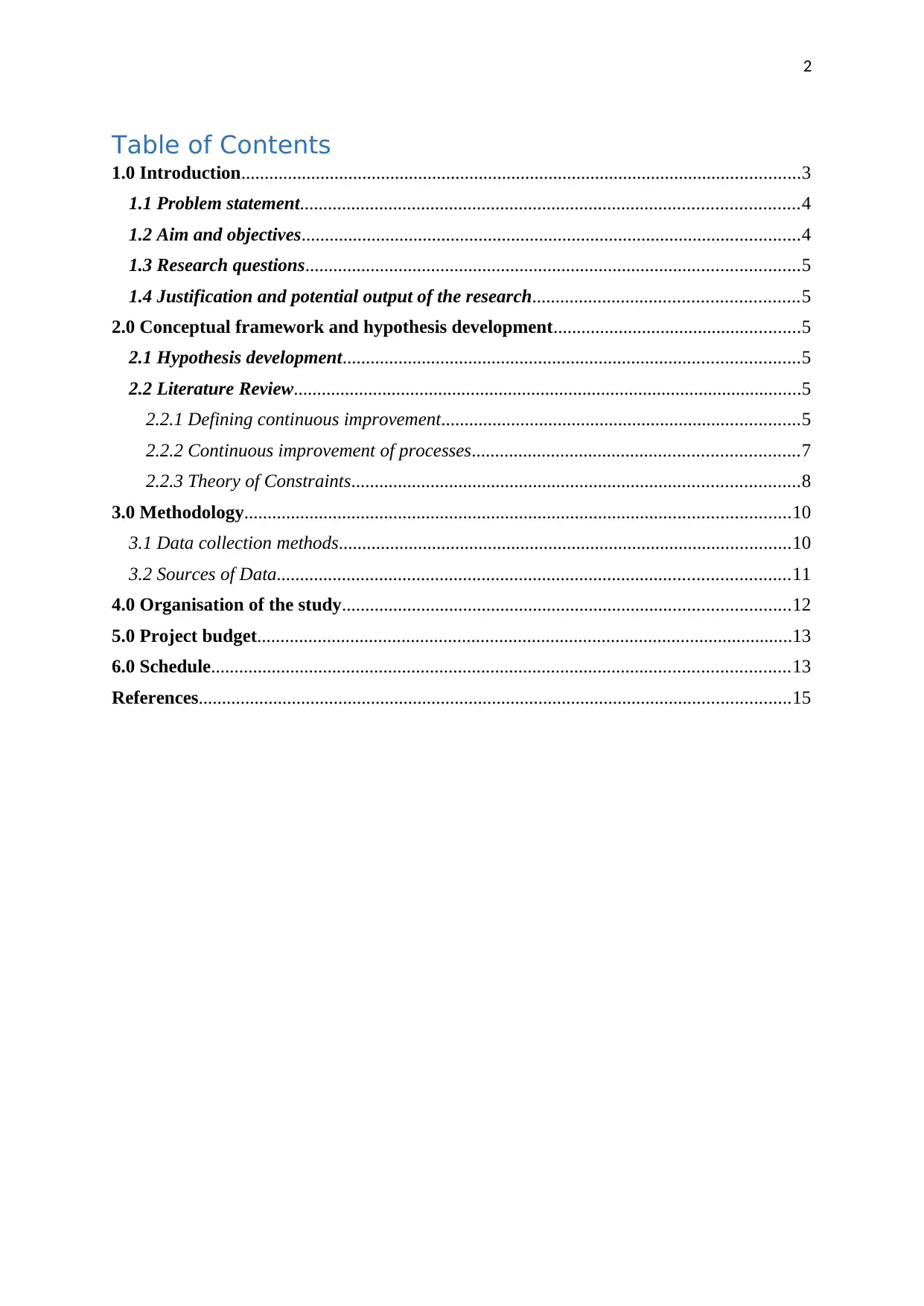
2
Table of Contents
1.0 Introduction........................................................................................................................3
1.1 Problem statement...........................................................................................................4
1.2 Aim and objectives...........................................................................................................4
1.3 Research questions..........................................................................................................5
1.4 Justification and potential output of the research.........................................................5
2.0 Conceptual framework and hypothesis development.....................................................5
2.1 Hypothesis development..................................................................................................5
2.2 Literature Review.............................................................................................................5
2.2.1 Defining continuous improvement.............................................................................5
2.2.2 Continuous improvement of processes......................................................................7
2.2.3 Theory of Constraints................................................................................................8
3.0 Methodology.....................................................................................................................10
3.1 Data collection methods.................................................................................................10
3.2 Sources of Data..............................................................................................................11
4.0 Organisation of the study................................................................................................12
5.0 Project budget...................................................................................................................13
6.0 Schedule............................................................................................................................13
References...............................................................................................................................15
Table of Contents
1.0 Introduction........................................................................................................................3
1.1 Problem statement...........................................................................................................4
1.2 Aim and objectives...........................................................................................................4
1.3 Research questions..........................................................................................................5
1.4 Justification and potential output of the research.........................................................5
2.0 Conceptual framework and hypothesis development.....................................................5
2.1 Hypothesis development..................................................................................................5
2.2 Literature Review.............................................................................................................5
2.2.1 Defining continuous improvement.............................................................................5
2.2.2 Continuous improvement of processes......................................................................7
2.2.3 Theory of Constraints................................................................................................8
3.0 Methodology.....................................................................................................................10
3.1 Data collection methods.................................................................................................10
3.2 Sources of Data..............................................................................................................11
4.0 Organisation of the study................................................................................................12
5.0 Project budget...................................................................................................................13
6.0 Schedule............................................................................................................................13
References...............................................................................................................................15
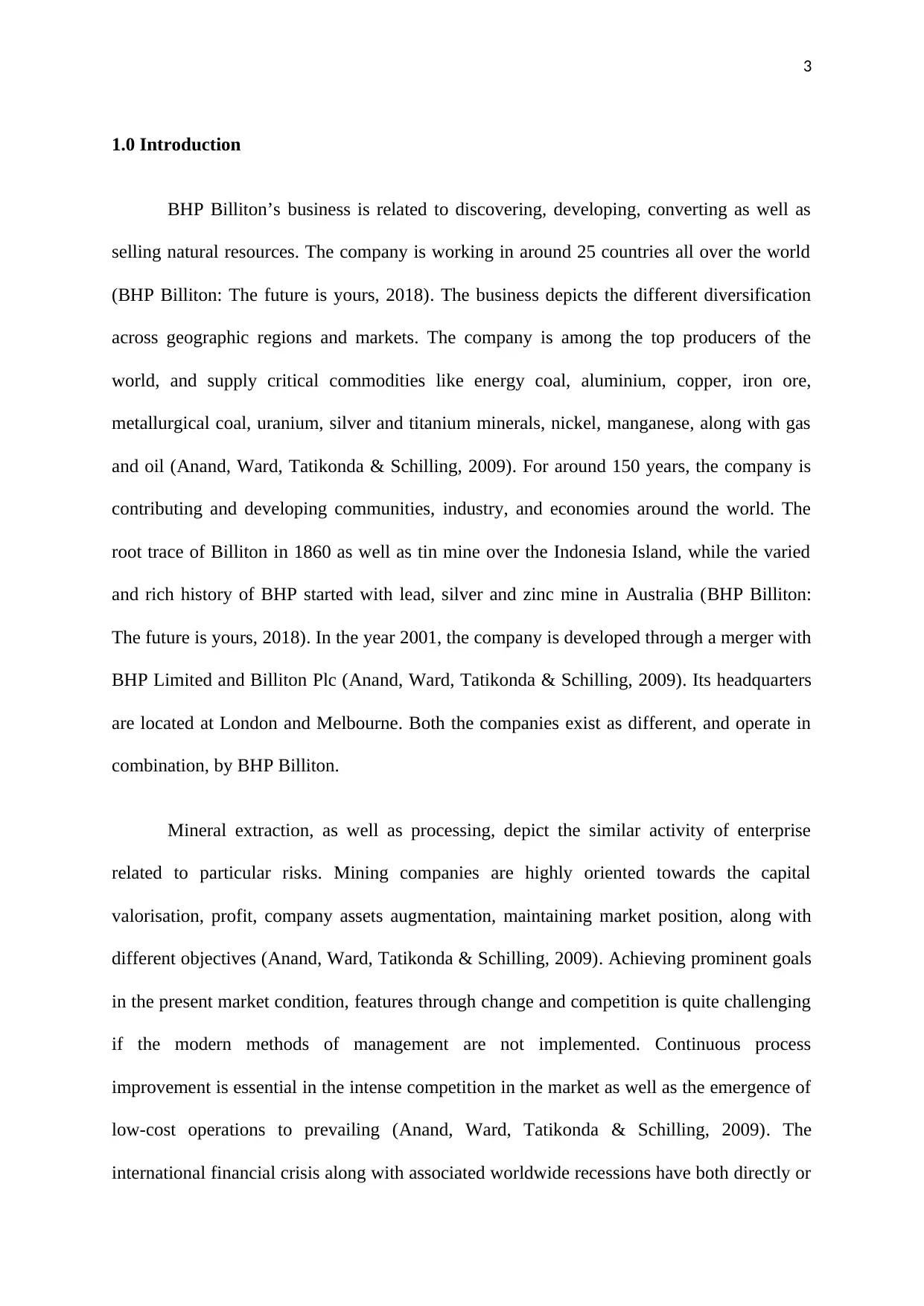
3
1.0 Introduction
BHP Billiton’s business is related to discovering, developing, converting as well as
selling natural resources. The company is working in around 25 countries all over the world
(BHP Billiton: The future is yours, 2018). The business depicts the different diversification
across geographic regions and markets. The company is among the top producers of the
world, and supply critical commodities like energy coal, aluminium, copper, iron ore,
metallurgical coal, uranium, silver and titanium minerals, nickel, manganese, along with gas
and oil (Anand, Ward, Tatikonda & Schilling, 2009). For around 150 years, the company is
contributing and developing communities, industry, and economies around the world. The
root trace of Billiton in 1860 as well as tin mine over the Indonesia Island, while the varied
and rich history of BHP started with lead, silver and zinc mine in Australia (BHP Billiton:
The future is yours, 2018). In the year 2001, the company is developed through a merger with
BHP Limited and Billiton Plc (Anand, Ward, Tatikonda & Schilling, 2009). Its headquarters
are located at London and Melbourne. Both the companies exist as different, and operate in
combination, by BHP Billiton.
Mineral extraction, as well as processing, depict the similar activity of enterprise
related to particular risks. Mining companies are highly oriented towards the capital
valorisation, profit, company assets augmentation, maintaining market position, along with
different objectives (Anand, Ward, Tatikonda & Schilling, 2009). Achieving prominent goals
in the present market condition, features through change and competition is quite challenging
if the modern methods of management are not implemented. Continuous process
improvement is essential in the intense competition in the market as well as the emergence of
low-cost operations to prevailing (Anand, Ward, Tatikonda & Schilling, 2009). The
international financial crisis along with associated worldwide recessions have both directly or
1.0 Introduction
BHP Billiton’s business is related to discovering, developing, converting as well as
selling natural resources. The company is working in around 25 countries all over the world
(BHP Billiton: The future is yours, 2018). The business depicts the different diversification
across geographic regions and markets. The company is among the top producers of the
world, and supply critical commodities like energy coal, aluminium, copper, iron ore,
metallurgical coal, uranium, silver and titanium minerals, nickel, manganese, along with gas
and oil (Anand, Ward, Tatikonda & Schilling, 2009). For around 150 years, the company is
contributing and developing communities, industry, and economies around the world. The
root trace of Billiton in 1860 as well as tin mine over the Indonesia Island, while the varied
and rich history of BHP started with lead, silver and zinc mine in Australia (BHP Billiton:
The future is yours, 2018). In the year 2001, the company is developed through a merger with
BHP Limited and Billiton Plc (Anand, Ward, Tatikonda & Schilling, 2009). Its headquarters
are located at London and Melbourne. Both the companies exist as different, and operate in
combination, by BHP Billiton.
Mineral extraction, as well as processing, depict the similar activity of enterprise
related to particular risks. Mining companies are highly oriented towards the capital
valorisation, profit, company assets augmentation, maintaining market position, along with
different objectives (Anand, Ward, Tatikonda & Schilling, 2009). Achieving prominent goals
in the present market condition, features through change and competition is quite challenging
if the modern methods of management are not implemented. Continuous process
improvement is essential in the intense competition in the market as well as the emergence of
low-cost operations to prevailing (Anand, Ward, Tatikonda & Schilling, 2009). The
international financial crisis along with associated worldwide recessions have both directly or
⊘ This is a preview!⊘
Do you want full access?
Subscribe today to unlock all pages.

Trusted by 1+ million students worldwide
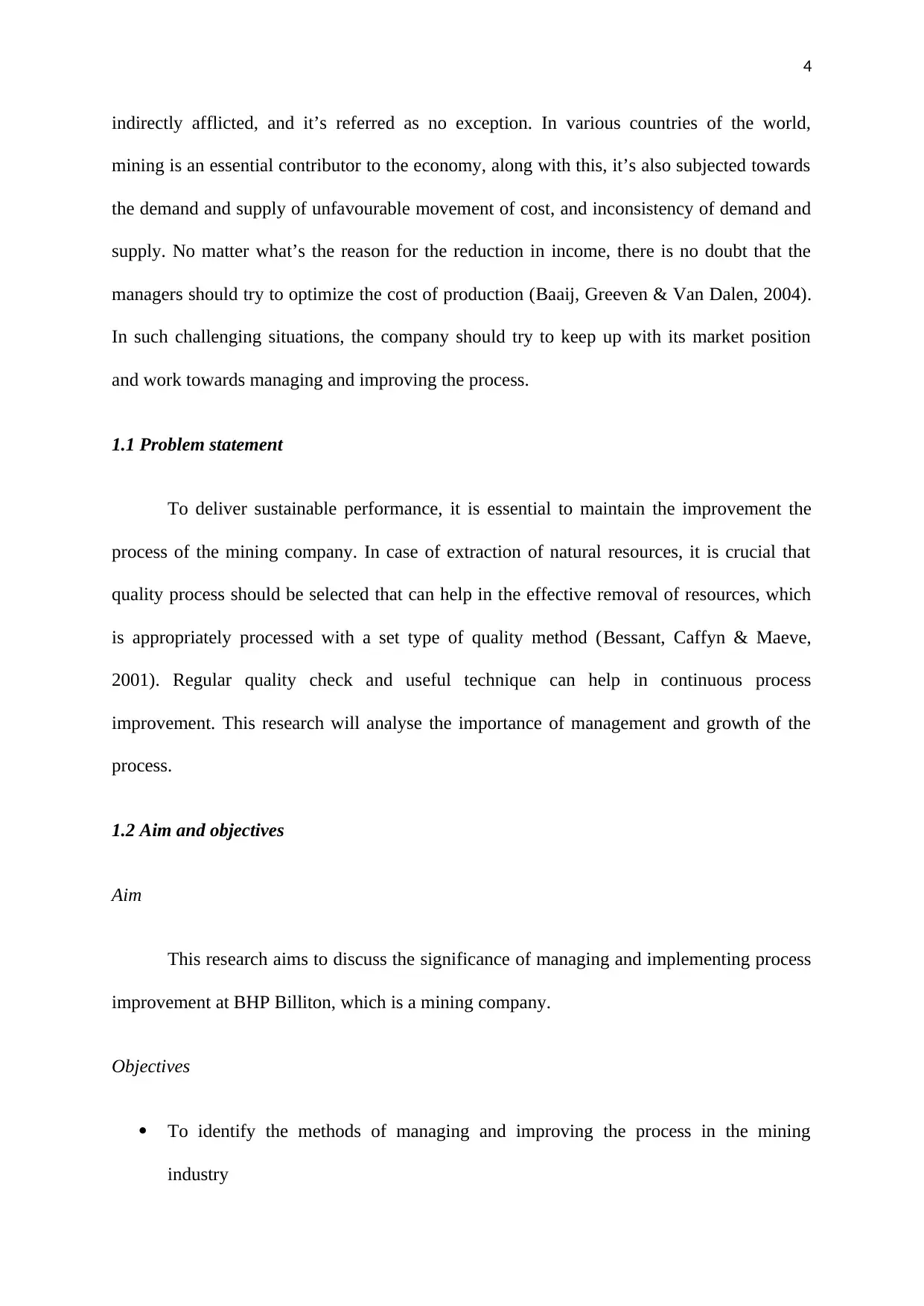
4
indirectly afflicted, and it’s referred as no exception. In various countries of the world,
mining is an essential contributor to the economy, along with this, it’s also subjected towards
the demand and supply of unfavourable movement of cost, and inconsistency of demand and
supply. No matter what’s the reason for the reduction in income, there is no doubt that the
managers should try to optimize the cost of production (Baaij, Greeven & Van Dalen, 2004).
In such challenging situations, the company should try to keep up with its market position
and work towards managing and improving the process.
1.1 Problem statement
To deliver sustainable performance, it is essential to maintain the improvement the
process of the mining company. In case of extraction of natural resources, it is crucial that
quality process should be selected that can help in the effective removal of resources, which
is appropriately processed with a set type of quality method (Bessant, Caffyn & Maeve,
2001). Regular quality check and useful technique can help in continuous process
improvement. This research will analyse the importance of management and growth of the
process.
1.2 Aim and objectives
Aim
This research aims to discuss the significance of managing and implementing process
improvement at BHP Billiton, which is a mining company.
Objectives
To identify the methods of managing and improving the process in the mining
industry
indirectly afflicted, and it’s referred as no exception. In various countries of the world,
mining is an essential contributor to the economy, along with this, it’s also subjected towards
the demand and supply of unfavourable movement of cost, and inconsistency of demand and
supply. No matter what’s the reason for the reduction in income, there is no doubt that the
managers should try to optimize the cost of production (Baaij, Greeven & Van Dalen, 2004).
In such challenging situations, the company should try to keep up with its market position
and work towards managing and improving the process.
1.1 Problem statement
To deliver sustainable performance, it is essential to maintain the improvement the
process of the mining company. In case of extraction of natural resources, it is crucial that
quality process should be selected that can help in the effective removal of resources, which
is appropriately processed with a set type of quality method (Bessant, Caffyn & Maeve,
2001). Regular quality check and useful technique can help in continuous process
improvement. This research will analyse the importance of management and growth of the
process.
1.2 Aim and objectives
Aim
This research aims to discuss the significance of managing and implementing process
improvement at BHP Billiton, which is a mining company.
Objectives
To identify the methods of managing and improving the process in the mining
industry
Paraphrase This Document
Need a fresh take? Get an instant paraphrase of this document with our AI Paraphraser
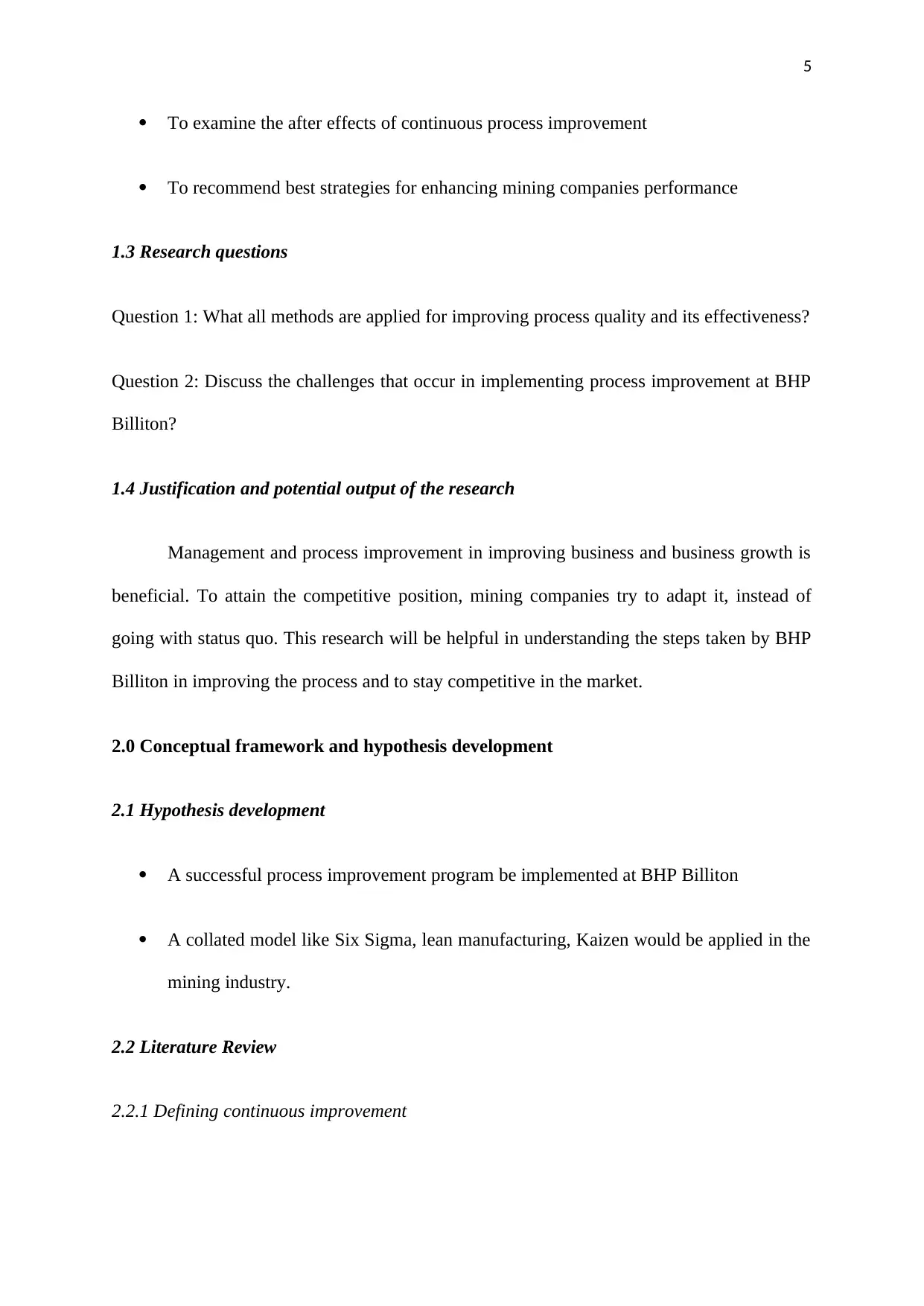
5
To examine the after effects of continuous process improvement
To recommend best strategies for enhancing mining companies performance
1.3 Research questions
Question 1: What all methods are applied for improving process quality and its effectiveness?
Question 2: Discuss the challenges that occur in implementing process improvement at BHP
Billiton?
1.4 Justification and potential output of the research
Management and process improvement in improving business and business growth is
beneficial. To attain the competitive position, mining companies try to adapt it, instead of
going with status quo. This research will be helpful in understanding the steps taken by BHP
Billiton in improving the process and to stay competitive in the market.
2.0 Conceptual framework and hypothesis development
2.1 Hypothesis development
A successful process improvement program be implemented at BHP Billiton
A collated model like Six Sigma, lean manufacturing, Kaizen would be applied in the
mining industry.
2.2 Literature Review
2.2.1 Defining continuous improvement
To examine the after effects of continuous process improvement
To recommend best strategies for enhancing mining companies performance
1.3 Research questions
Question 1: What all methods are applied for improving process quality and its effectiveness?
Question 2: Discuss the challenges that occur in implementing process improvement at BHP
Billiton?
1.4 Justification and potential output of the research
Management and process improvement in improving business and business growth is
beneficial. To attain the competitive position, mining companies try to adapt it, instead of
going with status quo. This research will be helpful in understanding the steps taken by BHP
Billiton in improving the process and to stay competitive in the market.
2.0 Conceptual framework and hypothesis development
2.1 Hypothesis development
A successful process improvement program be implemented at BHP Billiton
A collated model like Six Sigma, lean manufacturing, Kaizen would be applied in the
mining industry.
2.2 Literature Review
2.2.1 Defining continuous improvement
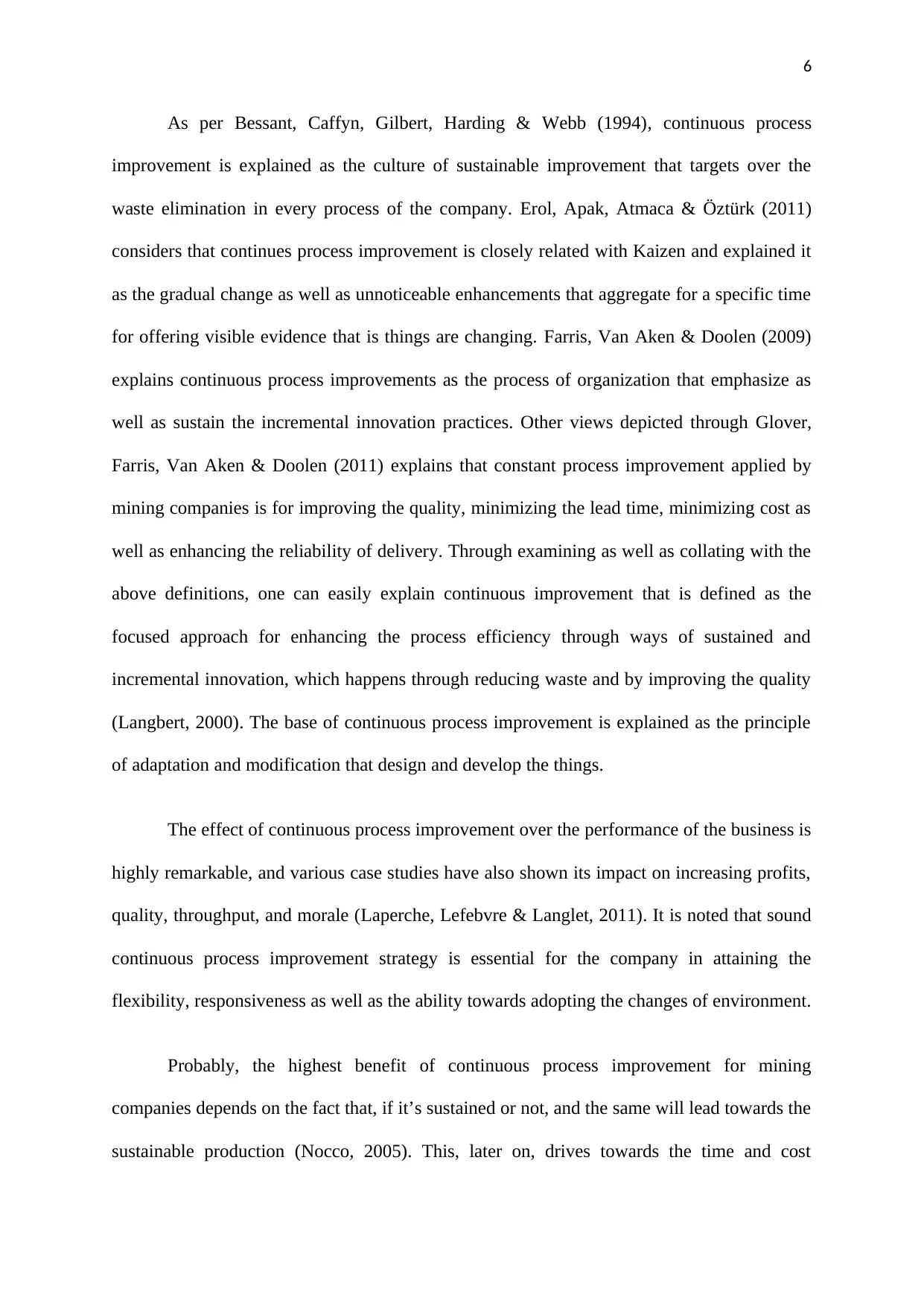
6
As per Bessant, Caffyn, Gilbert, Harding & Webb (1994), continuous process
improvement is explained as the culture of sustainable improvement that targets over the
waste elimination in every process of the company. Erol, Apak, Atmaca & Öztürk (2011)
considers that continues process improvement is closely related with Kaizen and explained it
as the gradual change as well as unnoticeable enhancements that aggregate for a specific time
for offering visible evidence that is things are changing. Farris, Van Aken & Doolen (2009)
explains continuous process improvements as the process of organization that emphasize as
well as sustain the incremental innovation practices. Other views depicted through Glover,
Farris, Van Aken & Doolen (2011) explains that constant process improvement applied by
mining companies is for improving the quality, minimizing the lead time, minimizing cost as
well as enhancing the reliability of delivery. Through examining as well as collating with the
above definitions, one can easily explain continuous improvement that is defined as the
focused approach for enhancing the process efficiency through ways of sustained and
incremental innovation, which happens through reducing waste and by improving the quality
(Langbert, 2000). The base of continuous process improvement is explained as the principle
of adaptation and modification that design and develop the things.
The effect of continuous process improvement over the performance of the business is
highly remarkable, and various case studies have also shown its impact on increasing profits,
quality, throughput, and morale (Laperche, Lefebvre & Langlet, 2011). It is noted that sound
continuous process improvement strategy is essential for the company in attaining the
flexibility, responsiveness as well as the ability towards adopting the changes of environment.
Probably, the highest benefit of continuous process improvement for mining
companies depends on the fact that, if it’s sustained or not, and the same will lead towards the
sustainable production (Nocco, 2005). This, later on, drives towards the time and cost
As per Bessant, Caffyn, Gilbert, Harding & Webb (1994), continuous process
improvement is explained as the culture of sustainable improvement that targets over the
waste elimination in every process of the company. Erol, Apak, Atmaca & Öztürk (2011)
considers that continues process improvement is closely related with Kaizen and explained it
as the gradual change as well as unnoticeable enhancements that aggregate for a specific time
for offering visible evidence that is things are changing. Farris, Van Aken & Doolen (2009)
explains continuous process improvements as the process of organization that emphasize as
well as sustain the incremental innovation practices. Other views depicted through Glover,
Farris, Van Aken & Doolen (2011) explains that constant process improvement applied by
mining companies is for improving the quality, minimizing the lead time, minimizing cost as
well as enhancing the reliability of delivery. Through examining as well as collating with the
above definitions, one can easily explain continuous improvement that is defined as the
focused approach for enhancing the process efficiency through ways of sustained and
incremental innovation, which happens through reducing waste and by improving the quality
(Langbert, 2000). The base of continuous process improvement is explained as the principle
of adaptation and modification that design and develop the things.
The effect of continuous process improvement over the performance of the business is
highly remarkable, and various case studies have also shown its impact on increasing profits,
quality, throughput, and morale (Laperche, Lefebvre & Langlet, 2011). It is noted that sound
continuous process improvement strategy is essential for the company in attaining the
flexibility, responsiveness as well as the ability towards adopting the changes of environment.
Probably, the highest benefit of continuous process improvement for mining
companies depends on the fact that, if it’s sustained or not, and the same will lead towards the
sustainable production (Nocco, 2005). This, later on, drives towards the time and cost
⊘ This is a preview!⊘
Do you want full access?
Subscribe today to unlock all pages.

Trusted by 1+ million students worldwide
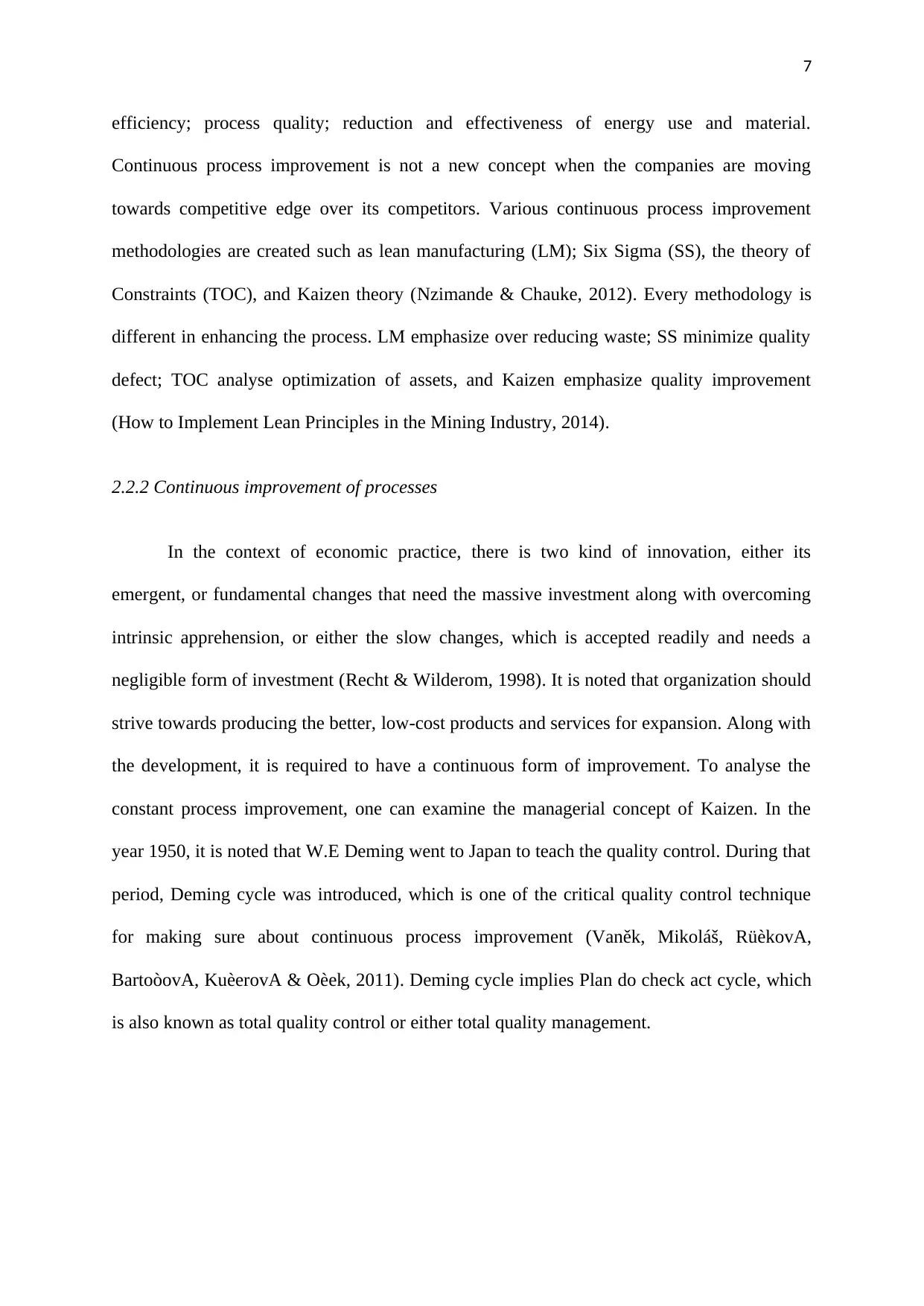
7
efficiency; process quality; reduction and effectiveness of energy use and material.
Continuous process improvement is not a new concept when the companies are moving
towards competitive edge over its competitors. Various continuous process improvement
methodologies are created such as lean manufacturing (LM); Six Sigma (SS), the theory of
Constraints (TOC), and Kaizen theory (Nzimande & Chauke, 2012). Every methodology is
different in enhancing the process. LM emphasize over reducing waste; SS minimize quality
defect; TOC analyse optimization of assets, and Kaizen emphasize quality improvement
(How to Implement Lean Principles in the Mining Industry, 2014).
2.2.2 Continuous improvement of processes
In the context of economic practice, there is two kind of innovation, either its
emergent, or fundamental changes that need the massive investment along with overcoming
intrinsic apprehension, or either the slow changes, which is accepted readily and needs a
negligible form of investment (Recht & Wilderom, 1998). It is noted that organization should
strive towards producing the better, low-cost products and services for expansion. Along with
the development, it is required to have a continuous form of improvement. To analyse the
constant process improvement, one can examine the managerial concept of Kaizen. In the
year 1950, it is noted that W.E Deming went to Japan to teach the quality control. During that
period, Deming cycle was introduced, which is one of the critical quality control technique
for making sure about continuous process improvement (Vaněk, Mikoláš, RüèkovA,
BartoòovA, KuèerovA & Oèek, 2011). Deming cycle implies Plan do check act cycle, which
is also known as total quality control or either total quality management.
efficiency; process quality; reduction and effectiveness of energy use and material.
Continuous process improvement is not a new concept when the companies are moving
towards competitive edge over its competitors. Various continuous process improvement
methodologies are created such as lean manufacturing (LM); Six Sigma (SS), the theory of
Constraints (TOC), and Kaizen theory (Nzimande & Chauke, 2012). Every methodology is
different in enhancing the process. LM emphasize over reducing waste; SS minimize quality
defect; TOC analyse optimization of assets, and Kaizen emphasize quality improvement
(How to Implement Lean Principles in the Mining Industry, 2014).
2.2.2 Continuous improvement of processes
In the context of economic practice, there is two kind of innovation, either its
emergent, or fundamental changes that need the massive investment along with overcoming
intrinsic apprehension, or either the slow changes, which is accepted readily and needs a
negligible form of investment (Recht & Wilderom, 1998). It is noted that organization should
strive towards producing the better, low-cost products and services for expansion. Along with
the development, it is required to have a continuous form of improvement. To analyse the
constant process improvement, one can examine the managerial concept of Kaizen. In the
year 1950, it is noted that W.E Deming went to Japan to teach the quality control. During that
period, Deming cycle was introduced, which is one of the critical quality control technique
for making sure about continuous process improvement (Vaněk, Mikoláš, RüèkovA,
BartoòovA, KuèerovA & Oèek, 2011). Deming cycle implies Plan do check act cycle, which
is also known as total quality control or either total quality management.
Paraphrase This Document
Need a fresh take? Get an instant paraphrase of this document with our AI Paraphraser
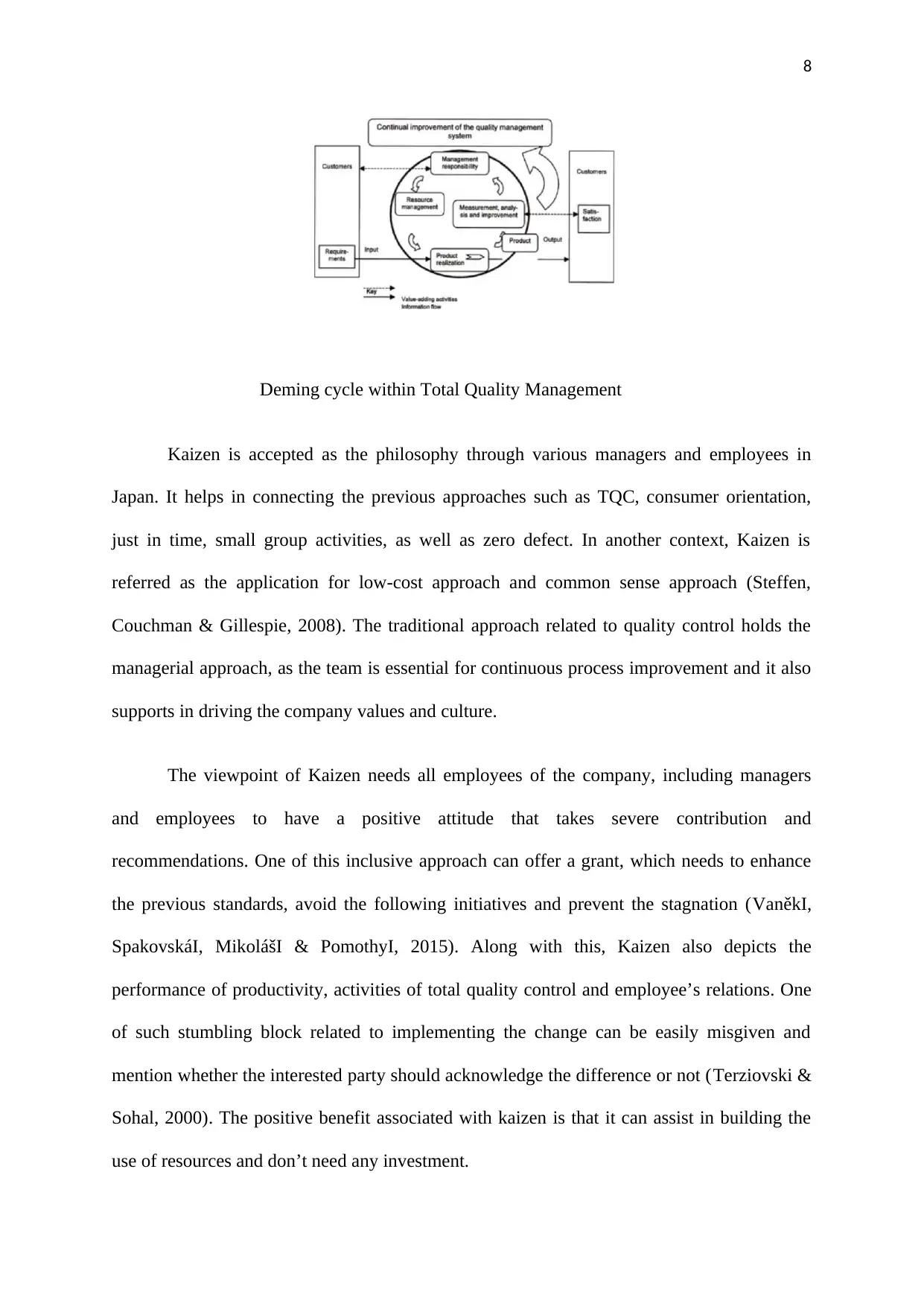
8
Deming cycle within Total Quality Management
Kaizen is accepted as the philosophy through various managers and employees in
Japan. It helps in connecting the previous approaches such as TQC, consumer orientation,
just in time, small group activities, as well as zero defect. In another context, Kaizen is
referred as the application for low-cost approach and common sense approach (Steffen,
Couchman & Gillespie, 2008). The traditional approach related to quality control holds the
managerial approach, as the team is essential for continuous process improvement and it also
supports in driving the company values and culture.
The viewpoint of Kaizen needs all employees of the company, including managers
and employees to have a positive attitude that takes severe contribution and
recommendations. One of this inclusive approach can offer a grant, which needs to enhance
the previous standards, avoid the following initiatives and prevent the stagnation (VaněkI,
SpakovskáI, MikolášI & PomothyI, 2015). Along with this, Kaizen also depicts the
performance of productivity, activities of total quality control and employee’s relations. One
of such stumbling block related to implementing the change can be easily misgiven and
mention whether the interested party should acknowledge the difference or not (Terziovski &
Sohal, 2000). The positive benefit associated with kaizen is that it can assist in building the
use of resources and don’t need any investment.
Deming cycle within Total Quality Management
Kaizen is accepted as the philosophy through various managers and employees in
Japan. It helps in connecting the previous approaches such as TQC, consumer orientation,
just in time, small group activities, as well as zero defect. In another context, Kaizen is
referred as the application for low-cost approach and common sense approach (Steffen,
Couchman & Gillespie, 2008). The traditional approach related to quality control holds the
managerial approach, as the team is essential for continuous process improvement and it also
supports in driving the company values and culture.
The viewpoint of Kaizen needs all employees of the company, including managers
and employees to have a positive attitude that takes severe contribution and
recommendations. One of this inclusive approach can offer a grant, which needs to enhance
the previous standards, avoid the following initiatives and prevent the stagnation (VaněkI,
SpakovskáI, MikolášI & PomothyI, 2015). Along with this, Kaizen also depicts the
performance of productivity, activities of total quality control and employee’s relations. One
of such stumbling block related to implementing the change can be easily misgiven and
mention whether the interested party should acknowledge the difference or not (Terziovski &
Sohal, 2000). The positive benefit associated with kaizen is that it can assist in building the
use of resources and don’t need any investment.
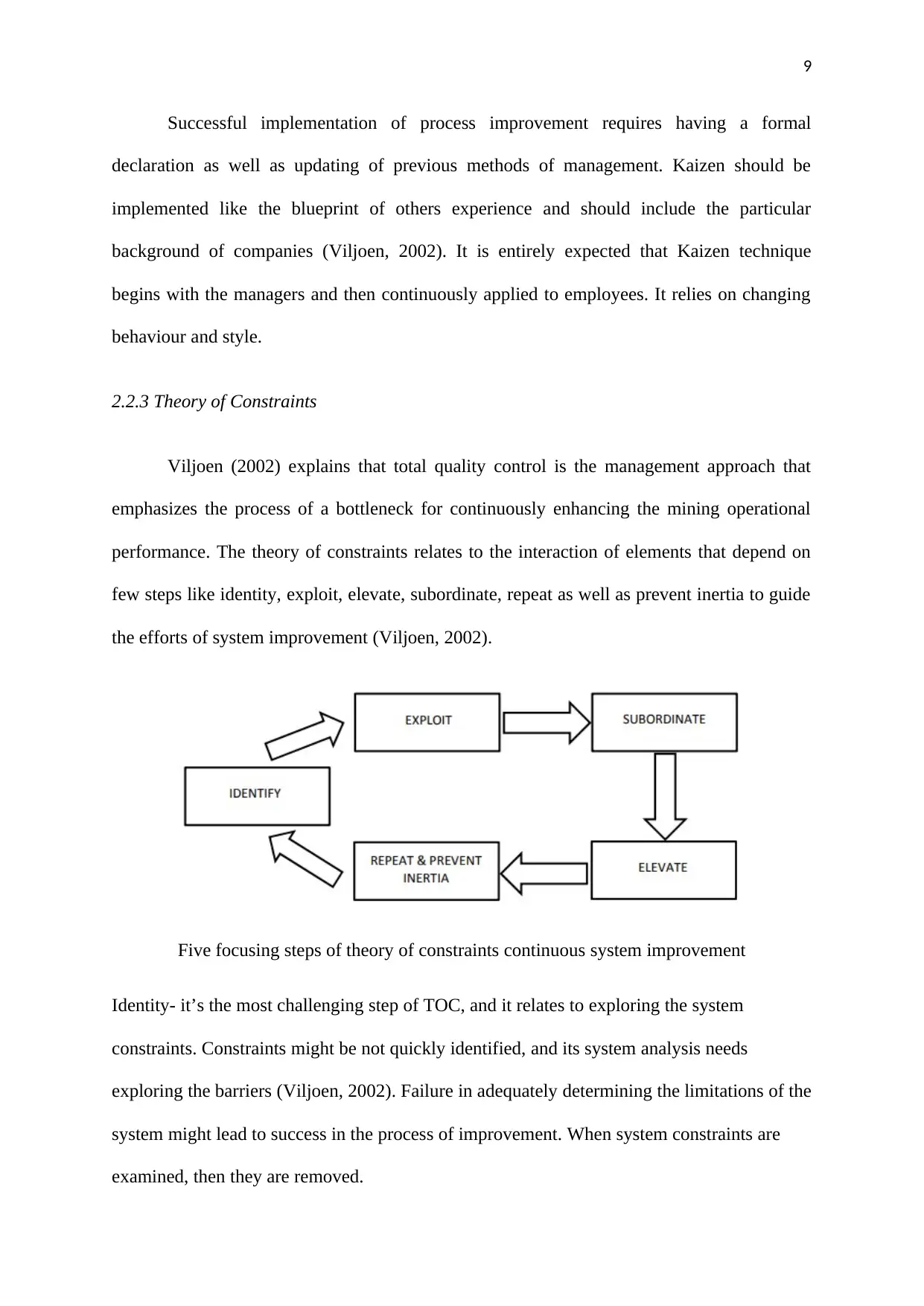
9
Successful implementation of process improvement requires having a formal
declaration as well as updating of previous methods of management. Kaizen should be
implemented like the blueprint of others experience and should include the particular
background of companies (Viljoen, 2002). It is entirely expected that Kaizen technique
begins with the managers and then continuously applied to employees. It relies on changing
behaviour and style.
2.2.3 Theory of Constraints
Viljoen (2002) explains that total quality control is the management approach that
emphasizes the process of a bottleneck for continuously enhancing the mining operational
performance. The theory of constraints relates to the interaction of elements that depend on
few steps like identity, exploit, elevate, subordinate, repeat as well as prevent inertia to guide
the efforts of system improvement (Viljoen, 2002).
Five focusing steps of theory of constraints continuous system improvement
Identity- it’s the most challenging step of TOC, and it relates to exploring the system
constraints. Constraints might be not quickly identified, and its system analysis needs
exploring the barriers (Viljoen, 2002). Failure in adequately determining the limitations of the
system might lead to success in the process of improvement. When system constraints are
examined, then they are removed.
Successful implementation of process improvement requires having a formal
declaration as well as updating of previous methods of management. Kaizen should be
implemented like the blueprint of others experience and should include the particular
background of companies (Viljoen, 2002). It is entirely expected that Kaizen technique
begins with the managers and then continuously applied to employees. It relies on changing
behaviour and style.
2.2.3 Theory of Constraints
Viljoen (2002) explains that total quality control is the management approach that
emphasizes the process of a bottleneck for continuously enhancing the mining operational
performance. The theory of constraints relates to the interaction of elements that depend on
few steps like identity, exploit, elevate, subordinate, repeat as well as prevent inertia to guide
the efforts of system improvement (Viljoen, 2002).
Five focusing steps of theory of constraints continuous system improvement
Identity- it’s the most challenging step of TOC, and it relates to exploring the system
constraints. Constraints might be not quickly identified, and its system analysis needs
exploring the barriers (Viljoen, 2002). Failure in adequately determining the limitations of the
system might lead to success in the process of improvement. When system constraints are
examined, then they are removed.
⊘ This is a preview!⊘
Do you want full access?
Subscribe today to unlock all pages.

Trusted by 1+ million students worldwide
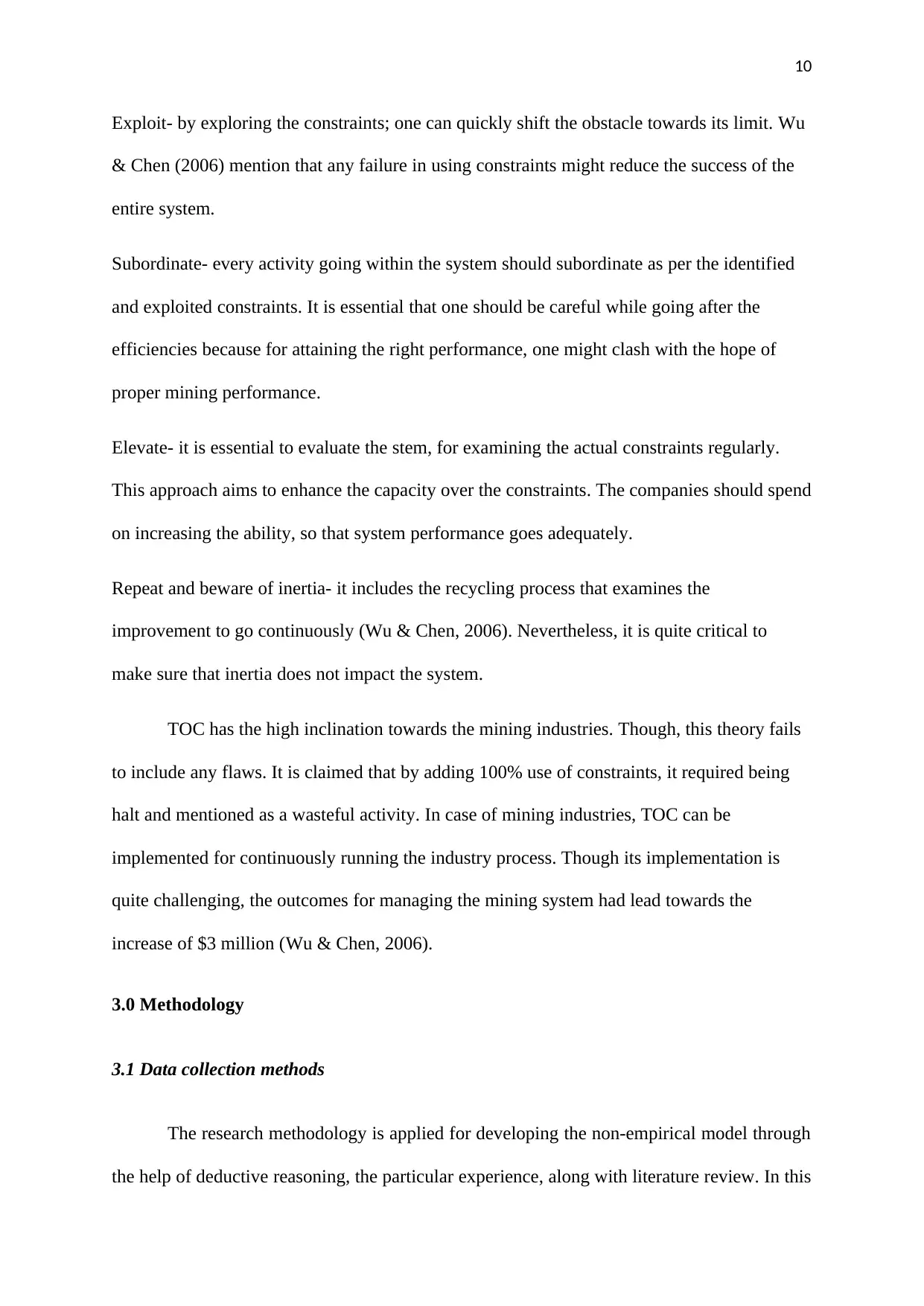
10
Exploit- by exploring the constraints; one can quickly shift the obstacle towards its limit. Wu
& Chen (2006) mention that any failure in using constraints might reduce the success of the
entire system.
Subordinate- every activity going within the system should subordinate as per the identified
and exploited constraints. It is essential that one should be careful while going after the
efficiencies because for attaining the right performance, one might clash with the hope of
proper mining performance.
Elevate- it is essential to evaluate the stem, for examining the actual constraints regularly.
This approach aims to enhance the capacity over the constraints. The companies should spend
on increasing the ability, so that system performance goes adequately.
Repeat and beware of inertia- it includes the recycling process that examines the
improvement to go continuously (Wu & Chen, 2006). Nevertheless, it is quite critical to
make sure that inertia does not impact the system.
TOC has the high inclination towards the mining industries. Though, this theory fails
to include any flaws. It is claimed that by adding 100% use of constraints, it required being
halt and mentioned as a wasteful activity. In case of mining industries, TOC can be
implemented for continuously running the industry process. Though its implementation is
quite challenging, the outcomes for managing the mining system had lead towards the
increase of $3 million (Wu & Chen, 2006).
3.0 Methodology
3.1 Data collection methods
The research methodology is applied for developing the non-empirical model through
the help of deductive reasoning, the particular experience, along with literature review. In this
Exploit- by exploring the constraints; one can quickly shift the obstacle towards its limit. Wu
& Chen (2006) mention that any failure in using constraints might reduce the success of the
entire system.
Subordinate- every activity going within the system should subordinate as per the identified
and exploited constraints. It is essential that one should be careful while going after the
efficiencies because for attaining the right performance, one might clash with the hope of
proper mining performance.
Elevate- it is essential to evaluate the stem, for examining the actual constraints regularly.
This approach aims to enhance the capacity over the constraints. The companies should spend
on increasing the ability, so that system performance goes adequately.
Repeat and beware of inertia- it includes the recycling process that examines the
improvement to go continuously (Wu & Chen, 2006). Nevertheless, it is quite critical to
make sure that inertia does not impact the system.
TOC has the high inclination towards the mining industries. Though, this theory fails
to include any flaws. It is claimed that by adding 100% use of constraints, it required being
halt and mentioned as a wasteful activity. In case of mining industries, TOC can be
implemented for continuously running the industry process. Though its implementation is
quite challenging, the outcomes for managing the mining system had lead towards the
increase of $3 million (Wu & Chen, 2006).
3.0 Methodology
3.1 Data collection methods
The research methodology is applied for developing the non-empirical model through
the help of deductive reasoning, the particular experience, along with literature review. In this
Paraphrase This Document
Need a fresh take? Get an instant paraphrase of this document with our AI Paraphraser
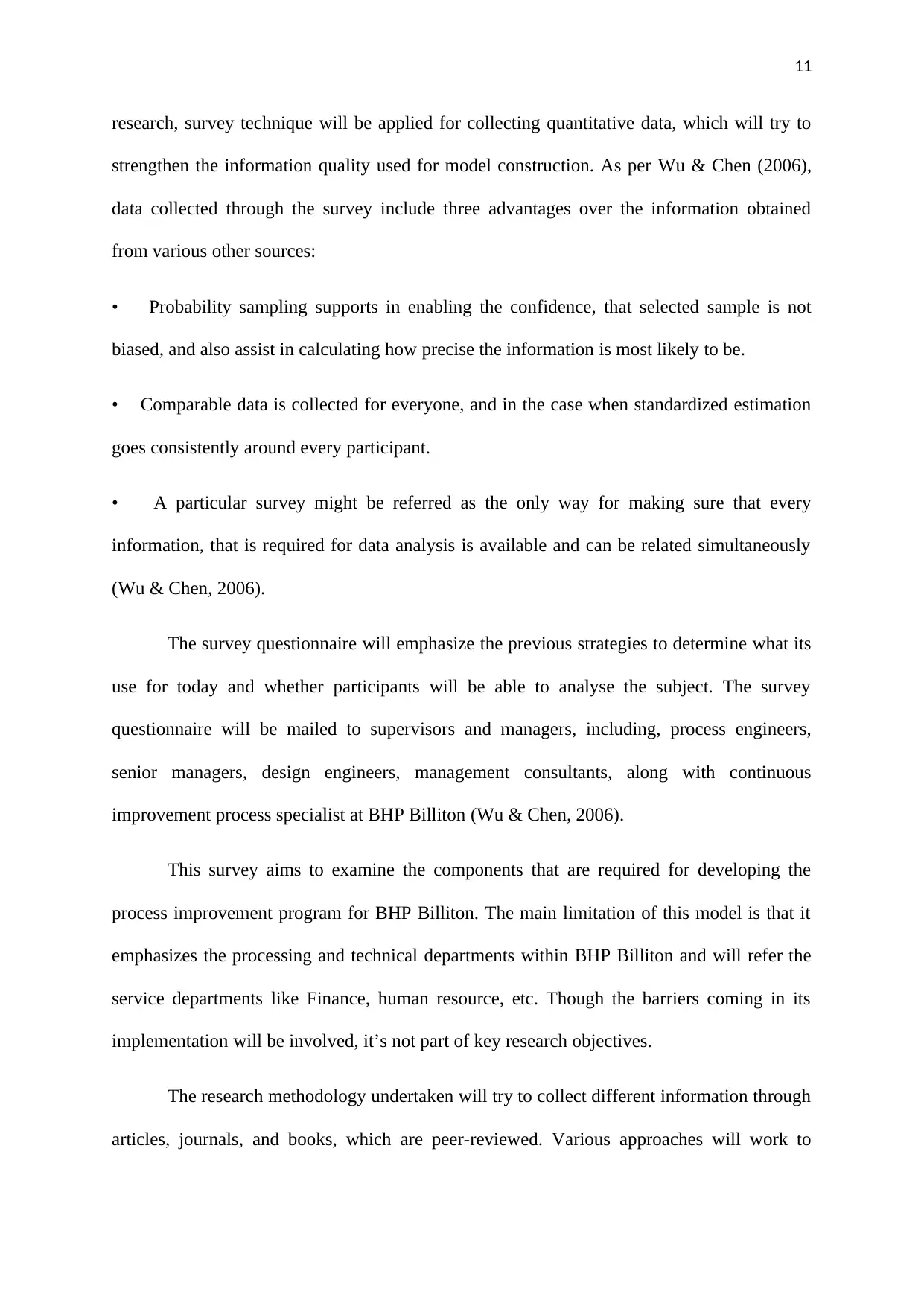
11
research, survey technique will be applied for collecting quantitative data, which will try to
strengthen the information quality used for model construction. As per Wu & Chen (2006),
data collected through the survey include three advantages over the information obtained
from various other sources:
• Probability sampling supports in enabling the confidence, that selected sample is not
biased, and also assist in calculating how precise the information is most likely to be.
• Comparable data is collected for everyone, and in the case when standardized estimation
goes consistently around every participant.
• A particular survey might be referred as the only way for making sure that every
information, that is required for data analysis is available and can be related simultaneously
(Wu & Chen, 2006).
The survey questionnaire will emphasize the previous strategies to determine what its
use for today and whether participants will be able to analyse the subject. The survey
questionnaire will be mailed to supervisors and managers, including, process engineers,
senior managers, design engineers, management consultants, along with continuous
improvement process specialist at BHP Billiton (Wu & Chen, 2006).
This survey aims to examine the components that are required for developing the
process improvement program for BHP Billiton. The main limitation of this model is that it
emphasizes the processing and technical departments within BHP Billiton and will refer the
service departments like Finance, human resource, etc. Though the barriers coming in its
implementation will be involved, it’s not part of key research objectives.
The research methodology undertaken will try to collect different information through
articles, journals, and books, which are peer-reviewed. Various approaches will work to
research, survey technique will be applied for collecting quantitative data, which will try to
strengthen the information quality used for model construction. As per Wu & Chen (2006),
data collected through the survey include three advantages over the information obtained
from various other sources:
• Probability sampling supports in enabling the confidence, that selected sample is not
biased, and also assist in calculating how precise the information is most likely to be.
• Comparable data is collected for everyone, and in the case when standardized estimation
goes consistently around every participant.
• A particular survey might be referred as the only way for making sure that every
information, that is required for data analysis is available and can be related simultaneously
(Wu & Chen, 2006).
The survey questionnaire will emphasize the previous strategies to determine what its
use for today and whether participants will be able to analyse the subject. The survey
questionnaire will be mailed to supervisors and managers, including, process engineers,
senior managers, design engineers, management consultants, along with continuous
improvement process specialist at BHP Billiton (Wu & Chen, 2006).
This survey aims to examine the components that are required for developing the
process improvement program for BHP Billiton. The main limitation of this model is that it
emphasizes the processing and technical departments within BHP Billiton and will refer the
service departments like Finance, human resource, etc. Though the barriers coming in its
implementation will be involved, it’s not part of key research objectives.
The research methodology undertaken will try to collect different information through
articles, journals, and books, which are peer-reviewed. Various approaches will work to
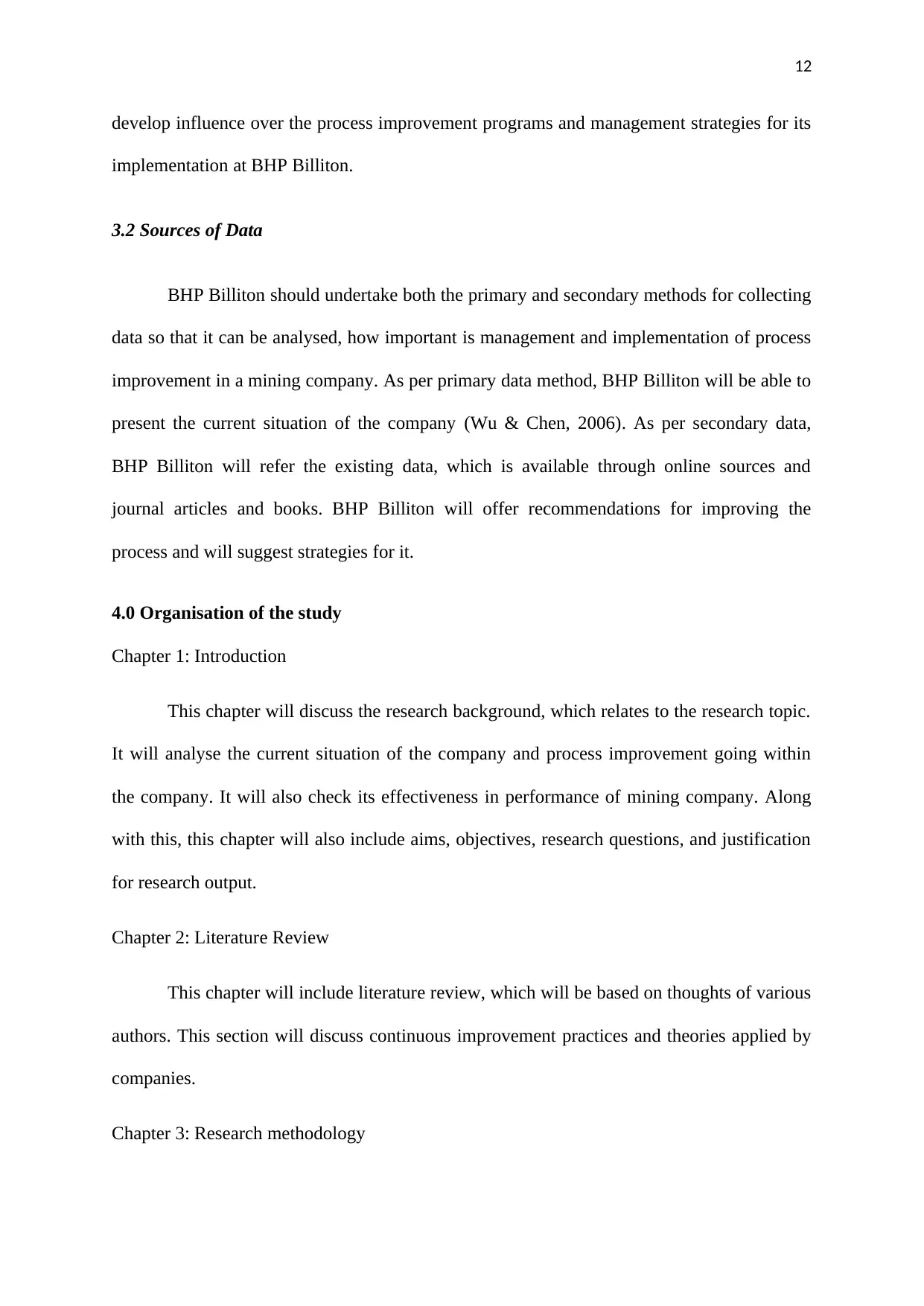
12
develop influence over the process improvement programs and management strategies for its
implementation at BHP Billiton.
3.2 Sources of Data
BHP Billiton should undertake both the primary and secondary methods for collecting
data so that it can be analysed, how important is management and implementation of process
improvement in a mining company. As per primary data method, BHP Billiton will be able to
present the current situation of the company (Wu & Chen, 2006). As per secondary data,
BHP Billiton will refer the existing data, which is available through online sources and
journal articles and books. BHP Billiton will offer recommendations for improving the
process and will suggest strategies for it.
4.0 Organisation of the study
Chapter 1: Introduction
This chapter will discuss the research background, which relates to the research topic.
It will analyse the current situation of the company and process improvement going within
the company. It will also check its effectiveness in performance of mining company. Along
with this, this chapter will also include aims, objectives, research questions, and justification
for research output.
Chapter 2: Literature Review
This chapter will include literature review, which will be based on thoughts of various
authors. This section will discuss continuous improvement practices and theories applied by
companies.
Chapter 3: Research methodology
develop influence over the process improvement programs and management strategies for its
implementation at BHP Billiton.
3.2 Sources of Data
BHP Billiton should undertake both the primary and secondary methods for collecting
data so that it can be analysed, how important is management and implementation of process
improvement in a mining company. As per primary data method, BHP Billiton will be able to
present the current situation of the company (Wu & Chen, 2006). As per secondary data,
BHP Billiton will refer the existing data, which is available through online sources and
journal articles and books. BHP Billiton will offer recommendations for improving the
process and will suggest strategies for it.
4.0 Organisation of the study
Chapter 1: Introduction
This chapter will discuss the research background, which relates to the research topic.
It will analyse the current situation of the company and process improvement going within
the company. It will also check its effectiveness in performance of mining company. Along
with this, this chapter will also include aims, objectives, research questions, and justification
for research output.
Chapter 2: Literature Review
This chapter will include literature review, which will be based on thoughts of various
authors. This section will discuss continuous improvement practices and theories applied by
companies.
Chapter 3: Research methodology
⊘ This is a preview!⊘
Do you want full access?
Subscribe today to unlock all pages.

Trusted by 1+ million students worldwide
1 out of 17